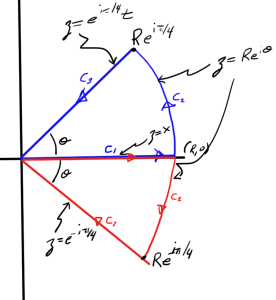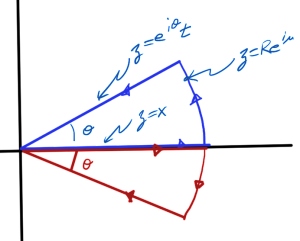[Click here for a PDF of this post with nicer formatting]
Question: Gauge transformed probability current ([1] pr. 2.37 (b))
For the gauge transformed Schrodinger equation
\begin{equation}\label{eqn:gaugeTxCurrent:20}
\inv{2m} \BPi(\Bx) \cdot \BPi(\Bx) \psi(\Bx, t) + e \phi(\Bx) \psi(\Bx, t) = i \Hbar \PD{t}{}\psi(\Bx, t),
\end{equation}
where
\begin{equation}\label{eqn:gaugeTxCurrent:40}
\BPi(\Bx) = -i \Hbar \spacegrad – \frac{e}{c} \BA(\Bx),
\end{equation}
find the probability current defined by
\begin{equation}\label{eqn:gaugeTxCurrent:60}
\PD{t}{\psi} + \spacegrad \cdot \Bj.
\end{equation}
Answer
Equation \ref{eqn:gaugeTxCurrent:20} and its conjugate are
\begin{equation}\label{eqn:gaugeTxCurrent:22}
\begin{aligned}
\inv{2m} \BPi \cdot \BPi \psi + e \phi \psi &= i \Hbar \PD{t}{\psi} \\
\inv{2m} \BPi^\conj \cdot \BPi^\conj \psi^\conj + e \phi \psi^\conj &= -i \Hbar \PD{t}{\psi^\conj}
\end{aligned}
\end{equation}
which can be used immediately in a chain rule expansion of the probability time derivative
\begin{equation}\label{eqn:gaugeTxCurrent:80}
\begin{aligned}
i \Hbar \PD{t}{\rho}
&=
i \Hbar \psi^\conj \PD{t}{\psi} +
i \Hbar \psi \PD{t}{\psi^\conj} \\
&=
\psi^\conj \lr{ \inv{2m} \BPi \cdot \BPi \psi + e \phi \psi } –
\psi \lr{ \inv{2m} \BPi^\conj \cdot \BPi^\conj \psi^\conj + e \phi \psi^\conj
} \\
&=
\inv{2m} \lr{
\psi^\conj \BPi \cdot \BPi \psi
-\psi \BPi^\conj \cdot \BPi^\conj \psi^\conj
}.
\end{aligned}
\end{equation}
We have a difference of conjugates, so can get away with expanding just the first term
\begin{equation}\label{eqn:gaugeTxCurrent:100}
\begin{aligned}
\psi^\conj \BPi \cdot \BPi \psi
&=
\psi^\conj
\psi \\
&=
\psi^\conj
\lr{ -i \Hbar \spacegrad – \frac{e}{c} \BA } \cdot \lr{ -i \Hbar \spacegrad – \frac{e}{c} \BA }
\psi \\
&=
\psi^\conj
\lr{
-\Hbar^2 \spacegrad^2 + \frac{i \Hbar e}{c} \lr{ \BA \cdot \spacegrad + \spacegrad \cdot \BA }
+ \frac{e^2}{c^2} \BA^2
}
\psi.
\end{aligned}
\end{equation}
Note that in the directional derivative terms, the gradient operates on everything to its right, including \( \BA \). Also note that the last term has no imaginary component, so it will not contribute to the difference of conjugates.
This gives
\begin{equation}\label{eqn:gaugeTxCurrent:120}
\begin{aligned}
\psi^\conj \BPi \cdot \BPi \psi – \psi \BPi^\conj \cdot \BPi^\conj \psi^\conj
&=
\psi^\conj
\lr{
-\Hbar^2 \spacegrad^2 \psi + \frac{i \Hbar e}{c} \lr{ \BA \cdot \spacegrad \psi + \spacegrad \cdot (\BA \psi) }
} \\
&\quad –
\psi
\lr{
-\Hbar^2 \spacegrad^2 \psi^\conj – \frac{i \Hbar e}{c} \lr{ \BA \cdot \spacegrad \psi^\conj + \spacegrad \cdot (\BA \psi^\conj) }
} \\
&=
-\Hbar^2 \lr{ \psi^\conj \spacegrad^2 \psi – \psi \spacegrad^2 \psi^\conj } \\
&\quad +
\frac{i \Hbar e}{c}
\lr{
\psi^\conj
\BA \cdot \spacegrad \psi + \psi^\conj \spacegrad \cdot (\BA \psi)
+
\psi
\BA \cdot \spacegrad \psi^\conj + \psi \spacegrad \cdot (\BA \psi^\conj)
}
\end{aligned}
\end{equation}
The first term is recognized as a divergence
\begin{equation}\label{eqn:gaugeTxCurrent:140}
\begin{aligned}
\spacegrad \cdot \lr{ \psi^\conj \spacegrad \psi – \psi \spacegrad \psi^\conj }
&=
\psi^\conj \spacegrad \cdot \spacegrad \psi
+
\spacegrad \psi \cdot \spacegrad \psi^\conj
–
\psi \spacegrad \cdot \spacegrad \psi^\conj
–
\spacegrad \psi^\conj \cdot \spacegrad \psi \\
&= \psi^\conj \spacegrad^2 \psi – \psi \spacegrad^2 \psi^\conj.
\end{aligned}
\end{equation}
The second term can also be factored into a divergence operation
\begin{equation}\label{eqn:gaugeTxCurrent:160}
\begin{aligned}
\psi^\conj
\BA \cdot \spacegrad \psi &+ \psi^\conj \spacegrad \cdot (\BA \psi)
+
\psi
\BA \cdot \spacegrad \psi^\conj + \psi \spacegrad \cdot (\BA \psi^\conj) \\
&=
\lr{ \psi^\conj\BA \cdot \spacegrad \psi
+\psi \spacegrad \cdot (\BA \psi^\conj)
}
+\lr{
\psi \BA \cdot \spacegrad \psi^\conj
+\psi^\conj \spacegrad \cdot (\BA \psi)
} \\
&= 2 \spacegrad \cdot \lr{ \BA \psi \psi^\conj } \\
\end{aligned}
\end{equation}
Putting all the pieces back together we have
\begin{equation}\label{eqn:gaugeTxCurrent:180}
\begin{aligned}
\PD{t}{\rho}
&=
\inv{2m i \Hbar} \lr{
\psi^\conj \BPi \cdot \BPi \psi
-\psi \BPi^\conj \cdot \BPi^\conj \psi^\conj
} \\
&=
\spacegrad \cdot
\inv{2m i \Hbar} \lr{
-\Hbar^2
\lr{ \psi^\conj \spacegrad \psi – \psi \spacegrad \psi^\conj }
+ \frac{ i \Hbar e}{c} 2 \BA \psi \psi^\conj
} \\
&=
\spacegrad \cdot
\lr{
\frac{i \Hbar}{2 m} \lr{ \psi^\conj \spacegrad \psi – \psi \spacegrad \psi^\conj }
+ \frac{e}{m c} \BA \psi \psi^\conj
}.
\end{aligned}
\end{equation}
From \ref{eqn:gaugeTxCurrent:60}, the probability current must be
\begin{equation}\label{eqn:gaugeTxCurrent:200}
\Bj
=
\frac{\Hbar}{2 i m} \lr{ \psi^\conj \spacegrad \psi – \psi \spacegrad \psi^\conj }
– \frac{e}{m c} \BA \psi \psi^\conj,
\end{equation}
or
\begin{equation}\label{eqn:gaugeTxCurrent:220}
\boxed{
\Bj
=
\frac{\Hbar}{m} \textrm{Im} \lr{ \psi^\conj \spacegrad \psi }
– \frac{e}{m c} \BA \psi \psi^\conj.
}
\end{equation}
References
[1] Jun John Sakurai and Jim J Napolitano. Modern quantum mechanics. Pearson Higher Ed, 2014.


